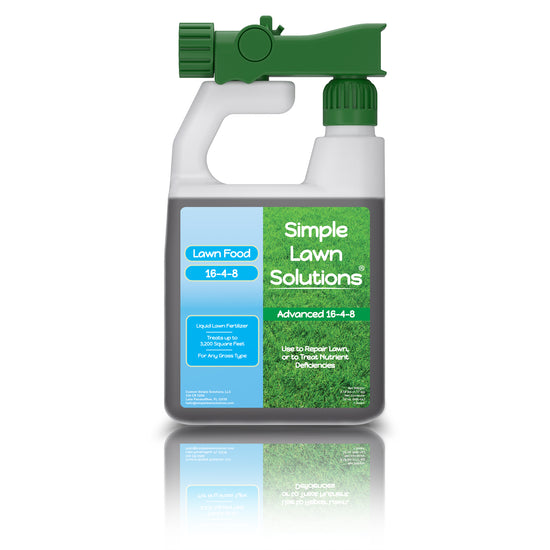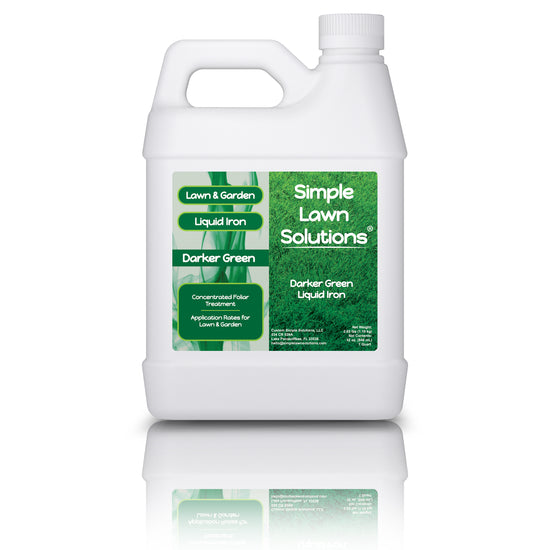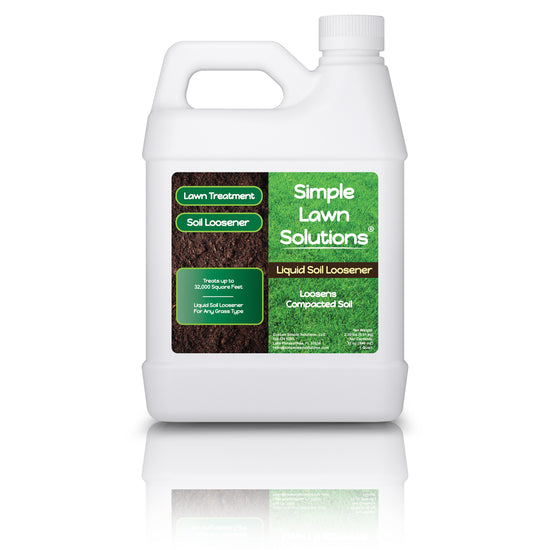Have you ever compared your lawn to your neighbors and wondered, what am I doing wrong? Is there something special about their lawn that makes it look greener, lusher, and full of life? Or maybe, after dormant season, your lawn doesn’t seem to get the memo that it’s time to grow again. Here at Simple Lawn Solutions, we will break down the steps to bring your lawn back to green and help it stay that way!
Dormant Lawn vs. Dead Lawn
A dead lawn and a dormant lawn are two very different things that are treated differently in terms of lawn care. Often, homeowners believe their dormant grass is actually dead, and begin all this extra work simply because they misidentified the problem. Dormant grass is grass that has stopped growing, most likely due to the season it’s in, but is still alive. Some grass remains dormant long into the growing season, and it takes some lawn care steps to get your dormant lawn to wake back up again and begin growing. If your grass is brown, it is most likely dormant instead of dead. When you walk on your lawn, it should crunch under your feet. While you might wince at the sound of a crunching lawn, that means only the top layer of grass has stopped growing; the soil underneath is poised for the next growing season!
Brown Grass
Brown grass is the key sign in dormancy, which means your lawn is merely asleep. But you might wonder why grass turns brown at all. In the winter, think of brown grass as smart, hibernating grass. In winter dormancy, your green lawn turns brown to conserve water and nutrients, so there is nothing to worry about until springtime comes back around. In the summer, grass turning brown is a sign of stressed out, sun-scorched lawn, or the response to a drought.
Signs Your Lawn is Dead
If you see completely different characteristics than the dormant signs we detailed above, then we’re just going to be blunt – your lawn might be dead. Rest in peace, your full, green lawn. Here are the signs that it’s time to start over, because your lawn is dead and gone:
- Water isn’t helping it grow
- Your lawn is pink, white, black, or red
- Feels spongy to walk on
- You can easily pull up sections/chunks of lawn, not just handfuls of grass leaves
- Sunshine makes matters worse, not better
Why Your Lawn is Dead
There are a few factors that contribute to a dying or dead lawn, and here are some of them:
- Drought
- Thatch – decomposed plant matter, too much causes buildup
- Mowing incorrectly
- Watering improperly
- Over-fertilizing
- Insect infestation
- Salt damage
- Pet spots
- Fungus
The Uncontrollable Factor for Lawns
Your hard work on your lawn is, unfortunately, no match for Mother Nature. The number one cause of a dead lawn is winter weather. While a certain amount of snow can actually keep your lawn hydrated, too much snow can lead to a type of mold that kills your grass. Additionally, if your neck of the woods experienced cold, harsh winds over the winter, there’s a chance your grass was deprived of the hydration it needed to withstand the damage. Even if your grass seems to have survived the middle of winter, it can still die right before spring. Crown freeze occurs when the sunshine of spring finally shows up, followed by a surprise winter cold front. The top of the grass that just absorbed that sunshine and water were quickly frozen, causing breakage from the expansion. A dead lawn in summer is a slow and steady process. Patches of lawn turn from brown and brittle to white and spongy as lack of water and shade dries out the entire lawn. Knowing why your lawn is dead can help you revive your grass, and also plan and adapt your lawn care routine for the future.

Establishing a New Lawn
-
Prepare Your Lawn
So, your lawn is dead. It’s time to roll up your sleeves and pull out the rake; you have to prepare your lawn before it’s ready to flourish again. The first step in bringing your lawn back to life is removing all signs of death. Take a look at your lawn for any signs of green life. If half of your lawn is still alive, then this will be a faster process. If you’ve come to terms with the fact that most (or all) of your lawn is dead, then prepare for the lawn care road ahead!
Scarification
Removing the dead patches is the most important part of preparing your lawn to come back to life. Scarification is the removal of dead grass by grabbing a springtime rake and going to work. If there are “bald” spots on your lawn, still rake over the soil to open it up, preparing it for the new seed you’ll put down. If your lawn died in the winter, mid-spring is the best time to scarify and begin the reviving process. You’ll have to live with a lackluster lawn for a bit, but it will maximize the benefits of your lawn care routine if you stay patient! If the middle of summer is what scorched your lawn, its best to wait until fall (usually September) to begin the process.
Tips to Scarification
To maximize the scarification process, follow these tips:
- About a week before you scarify, cut the lawn (even if it’s mostly dead grass)
- Make sure your lawn is not wet on scarification day
- Wait until warm, sunny conditions
- Avoid deep scarification on sloped parts of the lawn
- Make sure you have plenty of seed or sod on hand to quickly move onto the next step
-
Seed & Sod
Seed vs. Sod
There are two ways to bring fresh grass back to your lawn: seed your lawn, or lay down sod. Seeding your lawn means starting from scratch, it’s the less expensive option but takes a lot more patience! Sod is a transplant of mature grass, which is rolled out like a rug. It’s the faster path to a green lawn, but is more expensive and takes some time and measuring to get just right. Deciding between the two could depend on your time frame or budget, but there are benefits to both options.
Seeding Your Lawn
While the choice might already be clear for what best works for your lawn, we wanted to break down the benefits and disadvantages for choosing to seed your lawn over sod:
Benefits to seeding your lawn:
- Lower cost
- Low labor
- More choices of grass
- Pride of seeing your new lawn through from seed to maturation
Disadvantages of seeding:
- Small window of time to plant the seed
- Higher chance of weeds
- More maintenance in beginning stages
- Erosion could derail growth
- Longer maturation time
Laying Down Sod
Think the cost of sod is worth it? Here are the benefits versus the disadvantages of choosing sod over seed:
Benefits of sod:
- Quicker results
- Bigger window to lay sod than plant seeds
- Little or no weeds
- Faster path to foot traffic
Disadvantages of sod:
- More expensive
- More initial labor
- Might not “take” in growing conditions
- Short transplant windows – fresh sod laid within 24 hours of being cut
Choose between sod and seed early on in the process, because it will dictate the rest of the steps you take to bring your lawn back to life!
-
Feed Your Lawn
You’ve laid down your sod or planted your seed, but you need to make sure root development continues, your grass grows, and maintains a green lawn. The next steps of reviving your lawn all lie in your choice of fertilizer and your lawn care routine. The first few weeks of growth are so important in making sure your lawn flourishes and remains healthy. If you fertilize too soon, too late, or choose the wrong formula, you may have to start over at step one. We don’t want that to happen, so pay attention to our fertilizer tips for step three: feeding your lawn.
Fertilizer Window
How soon after seed or sod can you fertilize? Well, that depends on what option you chose. We recommend to fertilize directly before seeding if any nutrient deficiencies were detected on a soil test and then waiting until the lawn is sprouted and germinated before fertilizing your lawn again. If fresh sod is now in your yard, you should wait about six weeks before you fertilize, but you have a wider selection for choosing your fertilizer with the more mature option of sod.
Choosing a Lawn Fertilizer
Now that you know when to fertilize, it’s time to choose your formula. Choosing the wrong formula can inhibit growth, causing extra steps in your lawn care routine, so this step is vital to a lasting, green lawn. If you introduce a more mature fertilizer to an immature grass seed, you won’t see the initial root development and dense grass that you desire. For sod, the grass leaves are already established, it’s the roots that need the most attention, so a balanced fertilizer, introduced after the 6-week window, is the best lawn care option.
Seed Fertilizer
When it comes to feeding your seeds, think of it this way: babies eat baby food, grass seed eats starter fertilizer. At Simple Lawn Solutions, we carry a 3-18-18 Liquid Lawn Fertilizer that is a great starter fertilizer. The high phosphorous helps the seed roots take hold in your soil. The high potassium allows your seeds to grow stronger, giving them the strength they need to withstand hot or cold weather, and any stress that may be added to their environment.
Sod Fertilizer
Fertilizing sod is unique, because a lot of growth above ground is already established, with strong grass leaves. The attention needs to be below ground, to help your sod break through your soil and create lasting roots. For that reason, we suggest the 16-4-8 Balanced Liquid Lawn Food to provide your sod with the nitrogen it needs without ignoring the potassium and phosphorous essential to maintain the matured grass that already exists in the sod.
-
Dedicate to the Routine
Once you begin to see new growth, it’s time to perfect your routine so that you never have to deal with this again! Planning the right time to fertilize, aerate, mow, and water your grass will be imperative in your lawn care routine to keep your grass growing and green!
Mowing Routine
Especially if mowing was part of the causation of your dead lawn, pay closer attention to the best way to mow your lawn. If you love your lawn short, we have some bad news for you: a lawn that has too close of a mow is susceptible to more damage and retains less water. You can still mow your lawn short once in a while, but do not make it a habit. Keeping your lawn higher can also prevent weed growth, such as crabgrass. Your mower blades also play a role in keeping your lawn healthy and thriving. If your mower blades are dull, your mower might be tearing and ripping your grass, instead of cleanly cutting it with sharp blades. This effect will leave frayed grass behind, which is slower to heal, leaving the plant open to infection from fungal pathogens. Additionally, the frayed tips will die giving your lawn a brown tinge atop the leaf canopy. In short: frequent mowing at increased heights of cut is a great way to maintain a healthy, vigorous lawn!
Lawn Watering Routine
Watering: your grass dies if you water too much and it dies if you water too little. While you may understand the harsh impact that drought can have on your lawn, too much water can do just as much damage. Whether from heavy rain or a frequent sprinkler routine, too much watering can lead to standing water in your yard. Standing water can compact the soil from its weight, become a breeding ground for fungus, and reduce the oxygen that your plant roots need to function properly. Your watering routine will depend on your environment, grass type, and sprinkler system, but a general rule is one inch to one-and-a-half inches of water every week. Depending on your soil type, we recommend watering 2-3 times per week to total 1-1.5 inches. We recommend watering in the early morning, so your lawn is dry by nightfall, where a wet lawn can lead to fungus and disease.
Adapt to Drought
If the frequency of watering seems to be executing well in your lawn care routine, it’s important to adapt if there is a drought. Every neighborhood has different drought policies and considerations, so we will give you the bare minimum your lawn needs: provide your lawn with at least one inch of water weekly, to keep it alive in a drought. We recommend a half-inch of water two times a week. Adapting your lawn care routine in dry seasons can prevent your lawn from going from dormant, or staying dormant too long, into a dead lawn.
-
Be Proactive
You now understand how extremely difficult, though attainable, it is to bring your lawn back to life. We know you are willing to stay proactive in order to maintain a thriving, green lawn. Here are some of the best ways you can stay proactive and nip any possible threats to your lawn in the bud.
Yellowing Lawn
Yellowing is a sign of Nitrogen deficiency. You may consider a nitrogen lawn food with a nitrogen-enhanced fertilizer formula, such as the 28-0-0 Liquid Lawn Food for Green Growth.
Now that you have the lawn care steps to revive your dead lawn, it’s time to get started. Pick up the fertilizer and lawn booster you need at Simple Lawn Solutions, and keep an eye on our blog for more tips!










2 comments
Hi Charles, we recommend using the Growth Booster no sooner than 2 weeks after the 16-4-8. For more questions please email us at hello@simplelawnsolutions.com
I am about to place new sod down over the entire yard. You state to use the 16-4-8 formula spay and follow up your fertilizer with our Growth Booster. How soon after should I follow up? On the same day? A week later? A month later?